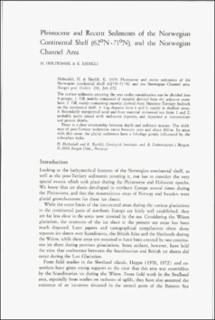| dc.contributor.author | Holtedahl, H. | |
| dc.contributor.author | Bjerkli, Kristian | |
| dc.date.accessioned | 2020-08-26T13:14:04Z | |
| dc.date.available | 2020-08-26T13:14:04Z | |
| dc.date.issued | 1975 | |
| dc.identifier.uri | https://hdl.handle.net/11250/2674996 | |
| dc.description.abstract | The surface sediments covering the area under consideration can be divided into 4 groups: 1. Till, mainly composed of material derived from the adjacent mainland. 2. Till, mainly containing material derived from Mesozoic-Tertiary bedrock on the continental shelf. 3. Lag deposits from 1 and 2, mainly in shallow areas. 4. Secondarily transported sand and finer material winnowed out from 1 and 2, probably partly mixed with meltwater deposits, and deposited at intermediate and greater depths. There is a clear relationship between depth and sediment texture. The thickness of post-Tertiary sediments varies between 0 and 400 m. In areas with thin cover, the glacial sediments have a lithology greatly influenced by the subsurface rocks. | |
| dc.language.iso | eng | |
| dc.relation.ispartofseries | NGU (316) | |
| dc.rights | Navngivelse 4.0 Internasjonal | |
| dc.rights.uri | http://creativecommons.org/licenses/by/4.0/deed.no | |
| dc.subject | PLEISTOCEN | |
| dc.subject | SEDIMENTOLOGI | |
| dc.title | Pleistocene and recent sediments of the Norwegian Continental Shelf (62°N-71°N), and the Norwegian Channel area. | |
| dc.type | Journal article | |
| dc.description.localcode | 35886 | |
| dc.source.pagenumber | 241-252 | |

